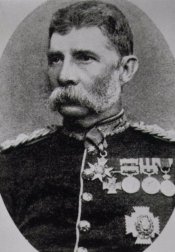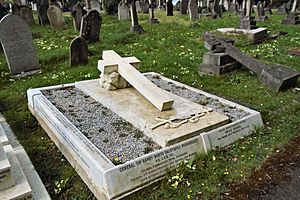Harry Prendergast facts for kids
Quick facts for kids
Sir Harry North Dalrymple Prendergast
|
|
|---|---|

Prendergast in 1886
|
|
| Born | 15 October 1834 Madras, India |
| Died | 24 July 1913 (aged 78) Richmond-upon-Thames, Surrey |
| Buried | |
| Allegiance | |
| Service/ |
Madras Army |
| Years of service | 1854–1892 |
| Rank | General |
| Unit | Madras Engineers Royal Engineers |
| Battles/wars | Anglo-Persian War Indian Rebellion of 1857 Abyssinian War Third Anglo-Burmese War |
| Awards | Victoria Cross Knight Grand Cross of the Order of the Bath |
| Relations | Thomas Prendergast (father) General Sir Harry Aubrey de Vere Maclean (son-in-law) |
Sir Harry North Dalrymple Prendergast (born October 15, 1834, died July 24, 1913) was a brave British general. He received the Victoria Cross (VC). This is the highest award for showing extreme bravery in battle. It is given to soldiers from Britain and Commonwealth countries.
Contents
Early Life and Military Start
Growing Up and School
Harry Prendergast was born in India in 1834. His parents were Thomas and Caroline Prendergast. He went to schools like Cheam School and Brighton College in England. Later, he even led the group for former students of Brighton College.
He also studied at special military schools. These were the Addiscombe Military Seminary and the Royal School of Military Engineering.
Joining the Army
In 1854, Harry joined the Madras Engineers. This was part of the Madras Army in India. He fought in the Persian War. After that, he returned to India in 1857.
Earning the Victoria Cross
A Daring Rescue
When he was 23, Harry Prendergast was a lieutenant in the Madras Sappers. This was during the Indian Rebellion of 1857. He showed amazing bravery on November 21, 1857, in a place called Mundisore.
He risked his own life to save Lieutenant G. Dew. Dew was in danger from an enemy soldier. Prendergast tried to stop the enemy, but he was shot and wounded. Luckily, another officer, Major Orr, saved him by killing the rebel.
More Acts of Courage
Prendergast also showed great courage in other battles. These included fights at Ratgurh and Betwa. In these battles, he was seriously wounded again.
General Sir Hugh Rose praised him highly. He mentioned Prendergast's bravery at Mundisore. He also noted how Prendergast volunteered to be his helper (Aide-de-Camp) in other battles. During one fight, his horse was killed. In another, he bravely charged with other soldiers against the enemy.
Receiving the Award
Harry Prendergast received his Victoria Cross from Queen Victoria. This happened at Windsor Castle on January 4, 1860. Twenty-four other brave soldiers also received their medals that day.
Later Military Career
Continuing to Serve
After the Indian Rebellion, Prendergast continued to serve. He was badly wounded and his left arm was permanently injured. But he kept serving in the Indian Army.
In 1867, he became a field engineer for the Abyssinian War. After this war, he was promoted. In 1878, he led Indian engineers to Malta and Cyprus. He then held several important jobs in India. He became a major-general in 1883.
Leading in Burma
In 1885, Prendergast was chosen to lead the Burma Field Force. This was during the Third Anglo-Burmese War. He quickly captured the city of Mandalay. For this success, he was made a Knight Commander of the Order of the Bath.
However, the war continued with a difficult uprising. Prendergast had limited resources. This made the campaign harder and affected his reputation. Even though he was promoted to lieutenant-general in 1886 and general in 1887, he did not lead any more major commands. He retired from the army in 1892.
Retirement and Honors
In retirement, Prendergast received another high honor. He was made a Knight Grand Cross of the Order of the Bath in 1902. King Edward VII presented him with this award. In 1908, he was appointed Colonel-Commandant of the Royal Engineers.
He passed away at age 78 in Richmond, Surrey, on July 24, 1913. He is buried in Richmond Cemetery.
He enjoyed many sports and activities. These included boxing, fencing, running, cricket, football, hunting, and polo. A bronze memorial tablet for him is in Brighton College Chapel.
Family Life
Prendergast was married to Emilie Rachael. They had several children:
- George William Yelverton Prendergast (around 1871–1903). He worked in the diplomatic service. He died at age 31.
- Ella Prendergast. She married General Sir Harry Aubrey de Vere Maclean in 1913.
The Victoria Cross Medal
For a while, people wondered if Prendergast's Victoria Cross medal was a copy. It was on loan to the National Army Museum. However, a study in 2020 checked the metal of the medal. It showed that it was very similar to other Victoria Crosses from the same time. This proved that it was real.
Today, the medal is on display at the Royal Engineers Museum in Chatham, England.


